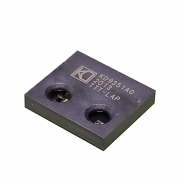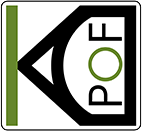From September 29 to October 1, 2021, KDPOF will display an update on optical gigabit networking in vehicles at the virtual SIAT – Symposium on International Automotive Technology 2021. Cars are not solely about driving anymore – electronic devices such as anti-collision cameras, DVD players, and navigation systems make the difference. Like infotainment systems, Automotive Driver Assistance Systems (ADAS) are becoming an integral part of the vehicle, with interfaces to many different clusters of electric/electronic systems. Read more
At the virtual Wire Harness Congress on September 22, 2021, KDPOF will inform about the status of Optical Multi-gigabit Connectivity in vehicles. In their presentation at 11:45, Juergen Schachtschneider, Automotive Manager Central Europe & Greater China, and César Esteban, Applications & Support Manager, will propose a complete optical communications system, which is under development by KDPOF and their industry partners. Read more
On August 13, 2021 from 11:00 a.m. to 12:30 p.m. IST (Indian Standard Time, 6:00 to 7:30 a.m. UTC), Óscar Ciordia, César Esteban, and Kenny Yoon will give the online seminar “The Use of Plastic Optical Fiber in the Automotive Industry”. The seminar is organized by the Society of Automotive Engineers India (SAE India). Read more
We are proud to participate in the EPIC (European Photonics Industry Consortium) network and connect with over 700 member companies in 35 countries. “EPIC is the ideal community to further drive the joint development and standardization of multi-gigabit technology in vehicles, which offers the automotive market an optical solution that is both competitive and robust,” stated Carlos Pardo. Read more
For BlastingTalks – Blasting News’ exclusive interviews with business and cultural leaders – Carlos Pardo has given an interview about KDPOF’s alternative to traditional fiber optics that allows for use in harsh environments and requires no technical expertise to install: Read more
Connected cars are being equipped with increasingly sophisticated systems such as high performance computers, a growing number of ADAS sensors including hires cameras, radars, lidars, and HMIs such as 4K screens and head-up displays. Thus, data rates go up to 20 Gbps. In addition, highly electrified powertrains imply electromagnetic interferences. Watch our video and learn how optical connectivity solves these issues and moves high-speed connectivity forward.
TV Report by RTVE: We visited the Digital Enterprise Show 2021, a very special edition that addresses digital and technological transformation. Spanish company KDPOF has created a new technology to transmit data at high speed over plastic optical fiber.
(The part with KDPOF starts at app. 4:15)
Carlos Pardo will give an online presentation about Automotive Optical Multi-gigabit Ethernet at the Automotive Technologies Virtual Conference on May 13, 2021 at 5:30 p.m. EST and on demand. In-Vehicle Network (IVN) requirements are quickly evolving with new challenges like automated driving or electric power trains. The IVN has to support use cases such the vehicle data backbone, smart antennas, ADAS cameras/sensors, and displays or data loggers which demand higher data bandwidth while maintaining the reliability level required by the automotive industry. A new IVN standard is needed for multi-gigabit optical communications.
This optical automotive IVN communication standard, 802.3cz, is currently under development within the IEEE and is supported by several industry-leading companies. The new standard will cover rates up to 50 Gbits/s and support several in-line connectors. The target BER is better than 10-12 with ambient operation temp from -40°C up to +105°C (AEC-Q100 grade 2) in harsh automotive environments. High reliability (15 years operation, less than 10 FIT), and outstanding EMC compliance will also be fulfilled. In his presentation, Carlos Pardo will cover the needed standard, and detail the components needed to make this a reality.
For more information and registration, please visit automotivevirtualconference.com
The new integrated KD9351 Fiber Optic Transceiver (FOT) from KDPOF further reduces costs for optical in-vehicle networks at 1 Gb/s. Incorporating the transmit and receive optoelectronics into one single component, the KD9351 is an optical transceiver for 100 Mb/s up to 1 Gb/s with a small footprint. “Compared to STP (shielded twisted pair of copper wires), the combination of the new KD9351 FOT with the continuing KD1053 IC cuts the cost for 1 Gb/s by 30 percent,” explained Carlos Pardo, CEO and Co-founder of KDPOF. “The new integrated device provides enhanced efficiency and flexibility. It thus paves the way to optical multi-gigabit Ethernet in the vehicle.” Applications for the new KD9351, with competitive pricing for EMC critical or galvanic isolated critical links, include safe Ethernet backbones and sensor links for advanced driver assist systems (ADAS).
KDPOF Provides Efficient Optical Technology for Safe Backbone and ADAS Sensor Links in Vehicles
KDPOF significantly lowers costs for the new KD9351 by constructing the transimpedance amplifier, photodiode, LED driver, and LED as one single device. Additional benefits are a shorter supply chain and no test duplication with the final test at the Tier1. Furthermore, the assembly of the FOT and the existing KD1053 IC is simplified and the connector offers snap-fit without soldering. The KD9351 reuses low-cost MEMs encapsulation and allows SMD reflow assembly with 8 by 7 mm LGA components. It is fully shielded against electromagnetic radiation. Fiber connection is done with a very simple plastic connector placed on top. The temperature range, from -40 °C to +105 °C, conforms with harsh automotive environmental requirements. The FOT withstands motor conditions with a vibration class of V2. Additionally, the device endures water without sealing. EMC performance is excellent even with the ECU shield case removed, as shielding is integrated into the PCB component. Optics implement Tx and Rx lenses. Samples are already available.
Carlos Pardo speaks to Sanjay Gangal of edacafe.com. Key questions have been: What are the key challenges for connectivity in electric vehicles? How can the cost issue be met? With autonomous driving ahead, the bandwidth required will speed up beyond one gigabit. How will the upcoming automotive network be able to meet speed and cost requirements?

By loading the video, you agree to YouTube's privacy policy.
Learn more
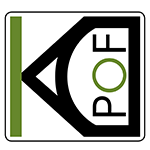

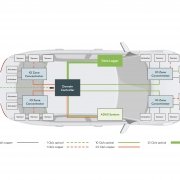 KDPOF
KDPOF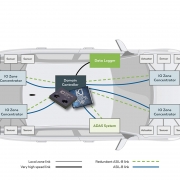
 metamorworks/iStock/Getty Images
metamorworks/iStock/Getty Images
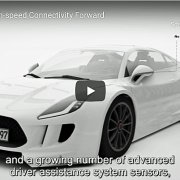
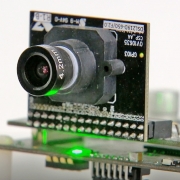

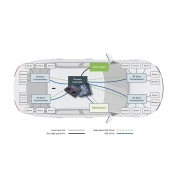 KDPOF
KDPOF